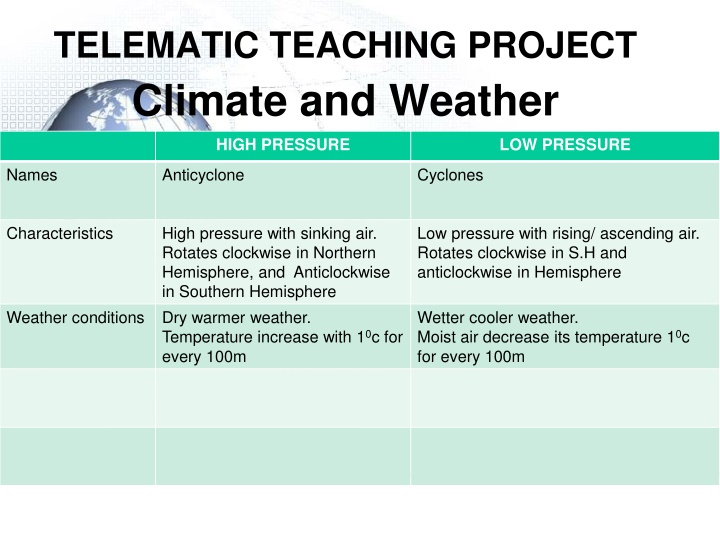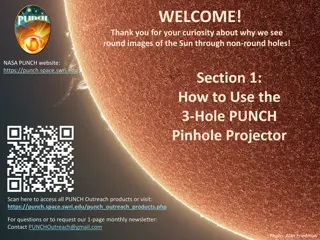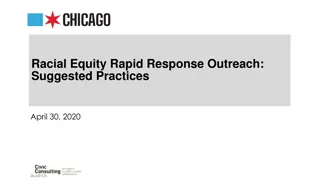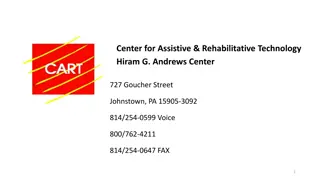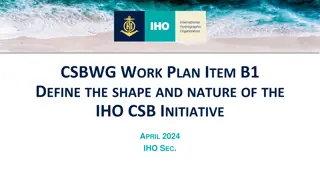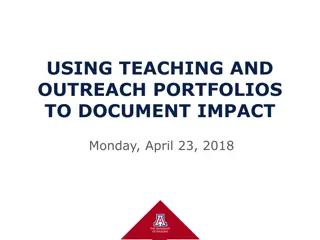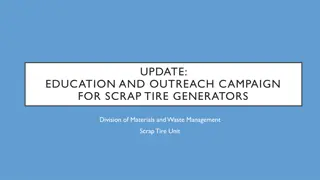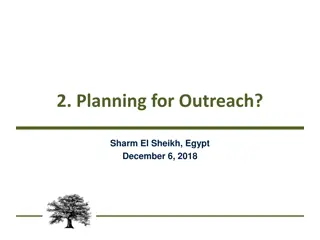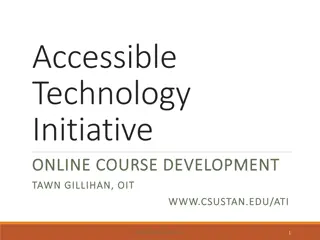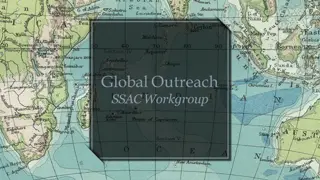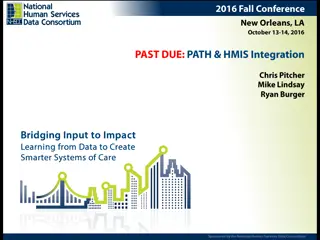OSTEMMP Technology Center Outreach Initiative
OSTEMMP, the OneOklahoma Science, Technology, Engineering & Mathematics Mentorship Program, connects technical professionals with students in Oklahoma to enhance education and research. Explore goals, career progression, and the program's impact.
Uploaded on Mar 17, 2025 | 0 Views
Download Presentation

Please find below an Image/Link to download the presentation.
The content on the website is provided AS IS for your information and personal use only. It may not be sold, licensed, or shared on other websites without obtaining consent from the author.If you encounter any issues during the download, it is possible that the publisher has removed the file from their server.
You are allowed to download the files provided on this website for personal or commercial use, subject to the condition that they are used lawfully. All files are the property of their respective owners.
The content on the website is provided AS IS for your information and personal use only. It may not be sold, licensed, or shared on other websites without obtaining consent from the author.
E N D
Presentation Transcript
TELEMATIC TEACHING PROJECT Climate and Weather HIGH PRESSURE LOW PRESSURE Names Anticyclone Cyclones Characteristics High pressure with sinking air. Rotates clockwise in Northern Hemisphere, and Anticlockwise in Southern Hemisphere Dry warmer weather. Temperature increase with 10c for every 100m Low pressure with rising/ ascending air. Rotates clockwise in S.H and anticlockwise in Hemisphere Weather conditions Wetter cooler weather. Moist air decrease its temperature 10c for every 100m
General characteristics of Midlatitude cyclone Other names: Frontal depression, temperate cyclone, extra tropical cyclone Midlatitude cyclone are found between400-60oN and S Hemisphere These cyclones occurs between 300-60oN and S Midlatitude cyclones move from West to east (driven/pushed by Westerlies) Occurs all year round in both hemispheres; affects South Africa in winter Associated with warm front, warm sector, cold front, cold sector Weather conditions associated with a cold front : overcast, low temperatures, strong winds, heavy rain (Cumulonimbus clouds) Western side of continents are affected by mid-latitudes cyclones They rotate clockwise in S. Hemisphere and anti in N. hemisphere They occur in families of 3-5 members with diameter of
How Midlatitude cyclone forms There must be temperature contrast between westerlies and polar easterlies to form polar front. There must be disturbance in Jet stream which pushes cold air into warm air. A low pressure develops when warm air rises above cold air as driven by westerlies. Conditions necessary for development of Midlatitude cyclone Difference between land and sea temperature Shape of coastline Acceleration of any of air masses Mountain ranges
MIDLATTITUDE CYCLONE: STAGES 1 INITIAL STAGE 2 DEVELOPMENT STAGE Westerlies Polar easterlies Polar front 4 OCCLUSION 3 MATURE STAGE FAMILY OF CYCLONES Midlatitude travels from West to East: with oldest on far South east and youngest on North West. They may follow each other as 3-5 members
MID-LATTITUDE CYCLONE STRATUS, CUMULUS CUMULONIMBUS Cold front Warm sector DRIZZLE LIGHT RAINFALL HEAVY RAINFALL THUNDERSTORM Isobar Wind rotation clockwise L Cold sector Rotate clockwise because we are in the Southern Hemisphere
Weather pattern associated with fronts: Cold front weather Warm front weather Warm sector weather 1.Wind backs( West to South West) 1.Wind changes from northwest to west 1.Pressure drops 2.Strong winds with low temperatures 2.More humidity with high temperatures 2.Has warm less dense air 3. Heavy rain with cumulonimbus clouds 3.Light rain with nimbostratus clouds 3.Associated with stratocumulus, altostratus clouds. 4. Pressure decreases as front approaches but rise as cold sector arrives IMPACT OF MIDLATITUDE ON HUMANS AND ENVIRONMENT Strong winds from thunderstorms, hail, and some snow can destroy infrastructure and kill people Communication is disrupted, shipping and aeroplanes cannot operate and out door activities 4.Decrease in air pressure Farmers may be negatively affected because these storms may destroy their crops, but it may also be a blessing by bringing necessary rainfall
TROPICAL CYCLONES Characteristics of Tropical cyclone Characteristics of Tropical cyclone Typhoon China/Japan Cyclone Indian ocean Willy willies Australia Hurricane - USA Formed around 50 N and 300S Hemisphere, and does not occur at equator (00) because there is no coriolis force. Occurs over tropics between 50 to 300 N and S hemisphere Movement/ Direction They travel from East to West driven by Easterly winds Season They occur late summer early autumn Other names Formation Occurance Areas affected Eastern side of continents in tropical latitudes Weather Intense thunderstorm, stormy vortex and the eye( centre of tropical cyclone with calm conditions) Rotation Rotate clockwise in Southern Hemisphere and anti-clockwise in Northern hemisphere Life Span They lasts a week. (4-7 days) and diameter of 200-750km
Factors necessary for FORMATION of tropical cyclone Occurs in a low pressure area, between 50 300 N and S equator Associated with heat required for uplift of air Occur over oceans with temp above 270C Do not occur at equator due to lack of coriolis force Characteristics Occur over warm oceans with 270C temp Do not occur at 00 to 40C Move from east to west Reason For constant supply of moisture No coriolis force They are driven by trade winds called tropical easterlies The heat is removed, friction and moisture is cut off. They die when they move inland Areas where tropical cyclone forms: Over warm oceans, between 50 300 Where there is uplift of air with temp above 270C
ASSOCIATED WEATHER PATTERNS OF TROPICAL CYCLONE 1. They are associated with dangerous weather conditions, with worse conditions on mature stage 2. They destroy property, environment and loss of life 3. Very high wind speed and cumulonimbus clouds around the eye. ( Heavy rainfall/torrential rain) 4. Storm surges in coastal areas with rise in sea level by many meters IMPACT OF TROPICAL CYCLONE ON HUMANS AND ENVIRONMENT IMPACT OF TROPICAL CYCLONE ON HUMANS AND ENVIRONMENT Flooding caused by storm surge, heavy rains swollen rivers Storm surges- sudden rise in sea level Damage infrastructure like roads, bridges, homes, sewage communication IMPACT OF TROPICAL C. Disruption of tourism, trade, agriculture and industry Outbreak of water borne diseases like cholera since floods have damaged sewages Loss of life
Putting evacuations in place, for getting people out of danger area Tracking cyclones and issuing early warnings Precautions and preventative strategies of Tropical cyclone Informing public of the risk and evacuating them Rescue of people from flooded areas CYCLONE DISASTER CYCLONE DISASTER MANAGEMENT MANAGEMENT Emergency relief, such as to give food, water and shelter Aid/ help from international countries for poor countries to help them recover from long term effects of cyclones
REGIONAL CLIMATE Line thunderstorms Berg winds
LINE THUNDERSTORMS WARM MOIST AIR COLD DRY AIR H H
Moisture front / Line thunderstorm Atlantic ocean 1. Cold air mass that blows from S.W. direction 2. This air mass comes from Atlantic ocean 3. It is influenced by Cold Benguela current 4. This air mass is pushed by South Atlantic H.P. / anticyclone towards the interior These two air masses meet at trough axis. Warm air is forced to rise and cold air wedges underneath. A line thunderstorm develops along moisture front with heavy rainfall associated with cumulonimbus clouds Indian ocean 1. Warm moist air mass that blows from N.E. direction 2. This air mass comes from Indian ocean 3. It is influenced by Mozambique ocean current 4. This air mass is pushed by South Indian H.P./ anticyclone towards the interior
Coastal low and Berg Winds Berg winds Coastal low pressure A. Berg winds are hot dry winds that blows from the interior towards the coast and are warmed up adiabatically as they descend: 10C/100m B. High pressure develops in interior and Low pressure over the coast C. Temperature drops fast by the cold air behind the front, and difference in pressure btw interior and coast ceases. D. Season: They occur in winter E. Results of berg winds: Veld fires F. Solutions: Fire fighters A. These are low pressure cells that often travel ahead of cold front B. They form off the west coast and travel east along the coast and change coastal weather. C. Rotate clockwise, with onshore winds on west that brings rain and fog and offshore winds on east with warm dry conditions
SOUTH AFRICAN BERGWIND Anti clockwise circulation High pressure in interior H Descending air heated Danger: Veldfires Warm dry wind at coast Low pressure over sea L
Role of inversion layer/ KALAHARI H.P Role of inversion layer/ KALAHARI H.P 1. During winter the KALAHARI H.P is dominant in the interior (strong). 2. The inversion layer is below the escarpment 3. Moisture from Indian ocean driven by Aghulas and Mozambique cannot reach the interior. 4. The results are DRY conditions in the interior in WINTER 1. During summer the KALAHARI is weak and shifts to N.E. direction 2. The inversion layer is above the escarpment 3. Moisture from the Indian ocean driven by Aghulas and Mozambique current can reach the interior. 1. The results are rainfall in the interior in Summer
EXAMINATION QUESTION WARM & DRY DRY FROM INTERIOR 1 Name the high pressure cell visible on the diagram. 2 During what season do berg winds affect the weather of South Africa? (1x1) 3 How does the wind in the diagram affect the weather along the coast of SA? 4 Explain why these weather conditions mentioned in question 3 occur. (1x1) 5 Name the environmental hazard associated with berg wind conditions. (1x1) 6 How are berg winds terminated (ended)? (1x1) (2x1)) (2x2)
VALLEY CLIMATES Aspect : The direction in which the slope faces. In Southern H. people chose North facing slope. Why: They are warmer because the sun is direct. Middle slopes are preferred In Katabatic: Bottom of valley has frost/fog
VALLEY CLIMATES ASPECT (SH) ASPECT: The direction in which the slope faces N O R T H S O U T H WARMER NO SNOW SNOW COLDER
Valley winds: are winds that blow along the length of the valley. INSOLATION ANABATIC KATABATIC WARM AIR Cold air decends During day land heated 1. Anabatic winds occurs during the DAY 1. At night the air lose energy through terrestrial radiation and become cold and dense hence SINKS. 2. Slopes are cooled down and air in contact also cools and SINKS. 3. Katabatic winds occurs at NIGHT. 2. In the morning the sun heats earth surface 3. The surrounding air is warmed up and forced to rise 4. The wind blows DOWNSLOPE and are known as Katabatic winds. 4) The wind blows UPSLOPE and is known as Anabatic wind
Urban Climates URBAN CLIMATES Difference between Rural and Urban climates : High temperature in CBD than the surrounding rural areas More artificial, concrete, tarred roads less water bodies, pollution and less vegetation Element Urban versus Rural Reason Temperature Cities are warmer Wind speed Less speed in cities Building act as windbreakers Humidity Less in cities Less plants thus less evapotranspiration Less water bodies due to drains More evaporation due to artificials Clouds, fog and precipitation More clouds , fog, smog in urban areas More dust in cities act as hygroscopic nuclei and promotes condenstaion Sunshine Less in cities High buildings block incoming sun rays and more shadow zone
Urban heat Island: High temperature in cities than the surrounding rural areas Solutions/strategies to reduce Urban Heat Island 1. Plant on roof tops 2. Plant more vegetation 3. Use synchronised robots 4. Flexi business times 5. Use public transport Causes of Urban Heat Island 1. Tall building which traps heat 2. Less vegetation that releases oxygen that cools city. 3. Air pollution that traps heat, as carbon dioxide traps long wave radiation 4. Artificials like concrete, tarred roads, pavements 5. Traffic congestion Effects of urban heat Island: Positive effects: 1. Less heating is required in cold places 2. Snowfall is reduced and roads are safer 3. More rainfall and condensation Negative effects: a) More air conditioners which uses more energy b) High temperature can lead to stroke, discomfort to people
